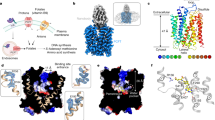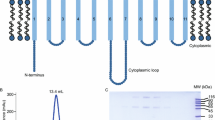Summary
An L1210 cell line (JT-1), which can grow in medium supplemented with 1nm folate, has been isolated. These cells exhibit a slower growth rate than folate-replete parental cells and have a lower ability to transport folate or methotrexate via the reduced folate transport system. Measurements at nanomolar concentrations of folate revealed that the adapted cells have acquired a high-affinity folate-binding protein. Binding to this component at 37°C was rapid and reached a maximum value after 30 min which corresponded in amount to 0.23±0.3 pmol/mg protein, and excess unlabeled folate added 30 min subsequent to the [3H]folate led to a rapid release of the bound substrate. Radioactivity bound to or released from the cells after 30 min at 37°C remained as unmetabolized folic acid. Binding was also rapid at 0°C but uptake at the plateau was only one-half the value obtained at 37°C. Half-maximal saturation of the binding component (K D) occurred at a folate concentration of 0.065nm at pH 7.4, while the affinity for folate decreased 30-fold when the pH was reduced to 6.2 (K D=2.0nm). 5-Methyltetrahydrofolate was also bound by this component (K i=13nm at pH 7.4) but with a much lower affinity than for folate, while progressively weaker interactions were observed with 5-formyltetrahydrofolate (K i=45nm) and methotrexate (K i=325nm). When the same adaptation procedure was performed with limiting amounts of 5-formyltetrahydrofolate, two additional cell lines, JT-2 and JT-3, were isolated which expressed elevated levels of the folate-binding protein. The binding activity of the latter cells was 0.46 and 1.4 pmol/mg protein, respectively. When the level of binding protein was compared in cells grown at different concentrations of folate, an increase in medium folate from 1 to 500nm caused a sevenfold reduction in binding activity in the JT-3 cell line, while these same growth conditions had no effect on binding by the other cells. These results indicate that L1210 cells adapted to low concentrations of folate or 5-formyltetrahydrofolate contain elevated levels of a high-affinity binding protein and that this protein is able to mediate the intracellular accumulation of folate compounds. L1210 cells thus appear to have two potential uptake routes for folate compounds, the previously characterized anion-exchange system and a second route mediated by a high-affinity binding protein. An additional low-affinity, high-capacity transport system for folate that had been proposed previously was not observed under a variety of experimental conditions in either the adapted or parental cells.
Similar content being viewed by others
References
Antony, A.C., Kane, M.A., Portillo, R.M., Elwood, P.C., Kolhouse, J.F. 1985. Studies of the role of a particulate folate-binding protein in the uptake of 5-methyltetrahydrofolate by cultured human KB cells.J. Biol. Chem. 260:14911–14917
Antony, A.C., Utley, C.S., Marcell, P.D., Kolhouse, J.F. 1982. Isolation, characterization, and comparison of the solubilized particulate and soluble folate-binding protein.J. Biol. Chem. 257:10081–10089
Antony, A.C., Utley, C., VanHorne, K.C., Kolhouse, J.F. 1981. Isolation and characterization of a folate receptor from human placenta.J. Biol. Chem. 256:9684–9692
Colman, N., Herbert, V. 1980. Folate-binding proteins.Annu. Rev. Med. 31:433–439
Goldman, I.D. 1975. Membrane transport of methotrexate (NSC-740) and other folate compounds: Relevance to rescue protocols.Cancer Chemother. Rep. 6:63–72
Goldman, I.D. 1977. Membrane transport of antifolates as a critical determinant of drug cytotoxicity.Adv. Exp. Med. Biol. 84:85–111
Goldman, I.D., Snow, R., White, J.C. 1975. The effect of methotrexate on the cellular accumulation of3H after incubation of Ehrlich ascites tumor with3H-folic acid.Fed. Proc. 34:807
Gornall, A.G., Bardawill, C.S., David, M.M. 1949. Determination of serum proteins by means of the biuret reaction.J. Biol. Chem. 177:751–766
Henderson, G.B. 1986. Folates and Pterins, Volume 3: Nutritional, Pharmacological, and Physiological Aspects. R.L. Blakley and M. Whitehead, editors. pp. 207–250. John Wiley & Sons, New York
Henderson, G.B., Montague-Wilkie, B. 1983. Irreversible inhibitors of methotrexate transport in L1210 cells: Characteristics of inhibition by anN-hydroxysuccinimide ester of methotrexate.Biochim. Biophys. Acta 735:123–130
Henderson, G.B., Suresh, M.R., Vitols, K.S., Huennekens, F.M. 1986. Transport of folate compounds in L1210 cells: Kinetic evidence that folate influx proceeds via the high-affinity transport system for 5-methyltetrahydrofolate and methotrexate.Cancer Res. 46:1639–1643
Henderson, G.B., Tsuji, M., Kumar, H.P. 1987. Transport of folate compounds by leukemic cells: Evidence for a single influx carrier for methotrexate, 5-methyltetrahydrofolate, and folate in CCRF-CEM human lymphoblasts.Biochem. Pharmacol. 36:3007–3014
Henderson, G.B., Zevely, E.M. 1983. Use of non-physiological buffers in the analysis of methotrexate transport in L1210 cells.Biochem. Int. 6:507–515
Henderson, G.B., Zevely, E.M. 1983. Structural requirements for anion substrates of the methotrexate transport system in L1210 cells.Arch. Biochem. Biophys. 221:438–446
Henderson, G.B., Zevely, E.M. 1984. Transport routes utilized by L1210 cells for the influx and efflux of methotrexate.J. Biol. Chem. 259:1526–1531
Henderson, G.B., Zevely, E.M., Kadner, R.J., Huennekens, F.M. 1977. The folate and thiamine transport proteins ofLactobacillus casei.J. Supramol. Struct. 6:239–247
Hill, B.T., Bailey, B.D., White, J.C., Goldman, I.D. 1979. Characteristics of transport of 4-amino antifolates and folate compounds by two lines of L5178Y lymphocytes, one with impaired transport of methotrexate.Cancer Res. 39:2440–2446
Huennekens, F.M., Vitols, K.S., Henderson, G.B. 1978. Transport of folate compounds in bacterial and mammalian cells.Adv. Enzymol. 47:313–346
Jackson, R.C., Niethammer, D., Huennekens, F.M. 1975. Enzymic and transport mechanisms of amethopterin resistance in L1210 mouse leukemia cells.Cancer Biochem. Biophys. 1:151–155
Kamen, B.A., Bertino, J.R. 1980. Folate and antifolate transport in mammalian cells.Antibiot. Chemother. 28:62–67
Kamen, B.A., Capdevila, A. 1986. Receptor-mediated folate accumulation is regulated by the cellular folate content.Proc. Natl. Acad. Sci. USA 83:5983–5987
McHugh, M., Cheng, Y.C. 1979. Demonstration of a high-affinity folate binder in human cell membranes and its characterization in cultured human KB cells.J. Biol. Chem. 254:11312–11318
Niethammer, D., Jackson, R.C. 1975. Changes of molecular properties associated with the development of resistance against methotrexate in human lymphoblastoid cells.Eur. J. Cancer 11:845–854
Niethammer, D., Jackson, R.C. 1976. Transport of folate compounds through the membrane of human lymphoblastoid cells.In: Chemistry and Biology of Pteridines. W. Pfeiderer, editor. pp. 197–206. Walter de Gruyter, Berlin
Rader, J.I., Niethammer, D., Huennekens F.M. 1974. Effects of sulfhydryl inhibitors upon transport of folate compounds in L1210 cells.Biochem. Pharmacol. 23:2057–2059
Sirotnak, F.M. 1980. Correlates of folate analog transport, pharmacokinetics, and selective antitumor action.Pharmacol. Ther. 8:71–103
Sirotnak, F.M., Goutas, L.J., Jacobsen, D.M., Mines, L.S., Barrueco, J.R., Gaumont, Y., Kisliuk, R.L. 1987. Carrier mediated transport of folate compounds in L1210 cells: Initial rate kinetics and extent of duality of entry routes for folic acid and diasteriomers of 5-methyltetrahydrohomofolate in the presence of physiological anions.Biochem. Pharmacol. 36:1659–1667
Sirotnak, F.M., Goutas, L.J., Mines, L.S. 1985. Extent of the requirement for folate transport by L1210 cells for growth and leukemogenesisin vivo.Cancer Res. 45:4732–4734
Sirotnak, F.M., Moccio, D.M., Yang, C.H. 1984. A novel class of genetic variants of the L1210 cell up-regulated for folate analogue transport inward: Isolation, characterization, and degree of metabolic instability of the system.J. Biol. Chem. 259:13139–13144
Steinbuch, M., Audran, R. 1969. The isolation of IgG from mammalian sera with the aid of caprylic acid.Arch. Biochem. Biophys. 134:279–284
Suresh, M.R., Henderson, G.B., Huennekens, F.M. 1979. Folate uptake in L1210 cells: Mediation by an adenine transport system.Biochem. Biophys. Res. Commun. 87:135–139
Yang, C.H., Dembo, M., Sirotnak, F.M. 1983. Relationships between carrier-mediated transport of folate compounds by L1210 leukemia cells: Evidence for multiplicity of entry routes with different kinetic properties expressed in plasma membrane vesicles.J. Membrane Biol. 75:11–20
Author information
Authors and Affiliations
Rights and permissions
About this article
Cite this article
Henderson, G.B., Tsuji, J.M. & Kumar, H.P. Mediated uptake of folate by a high-affinity binding protein in sublines of L1210 cells adapted to nanomolar concentrations of folate. J. Membrain Biol. 101, 247–258 (1988). https://doi.org/10.1007/BF01872839
Received:
Revised:
Issue Date:
DOI: https://doi.org/10.1007/BF01872839




